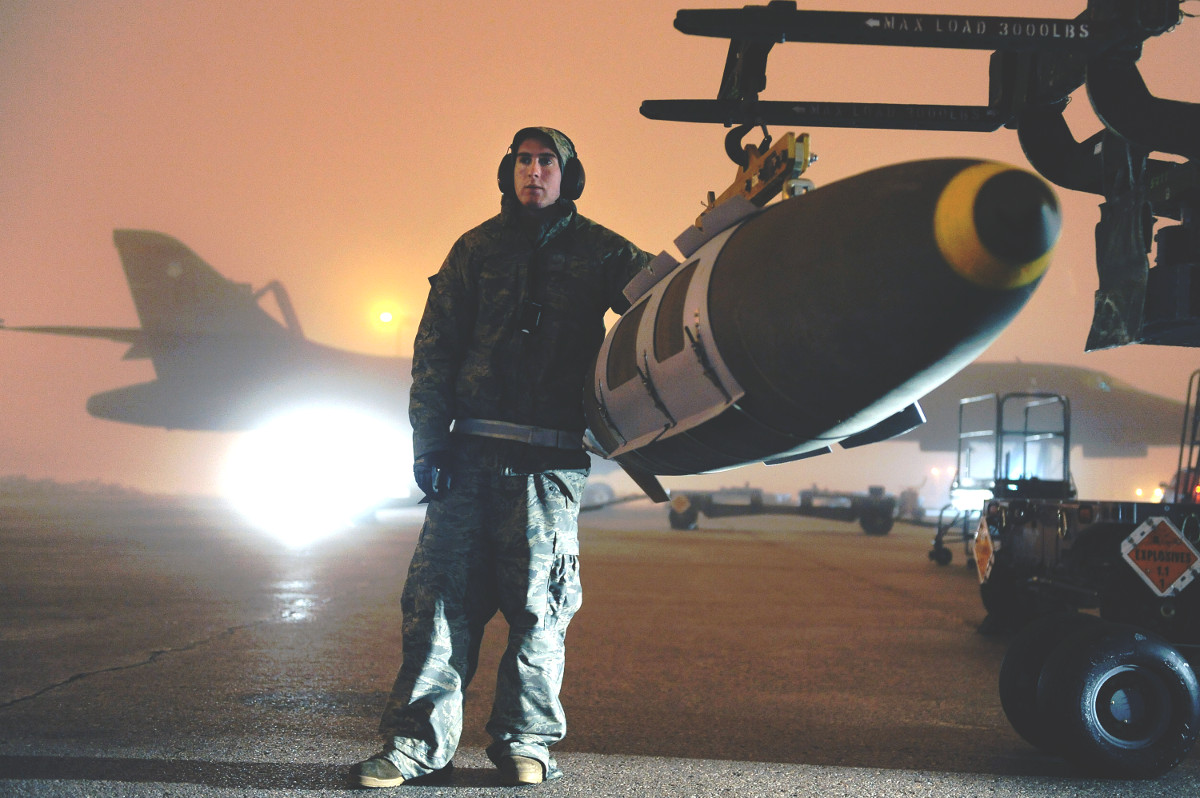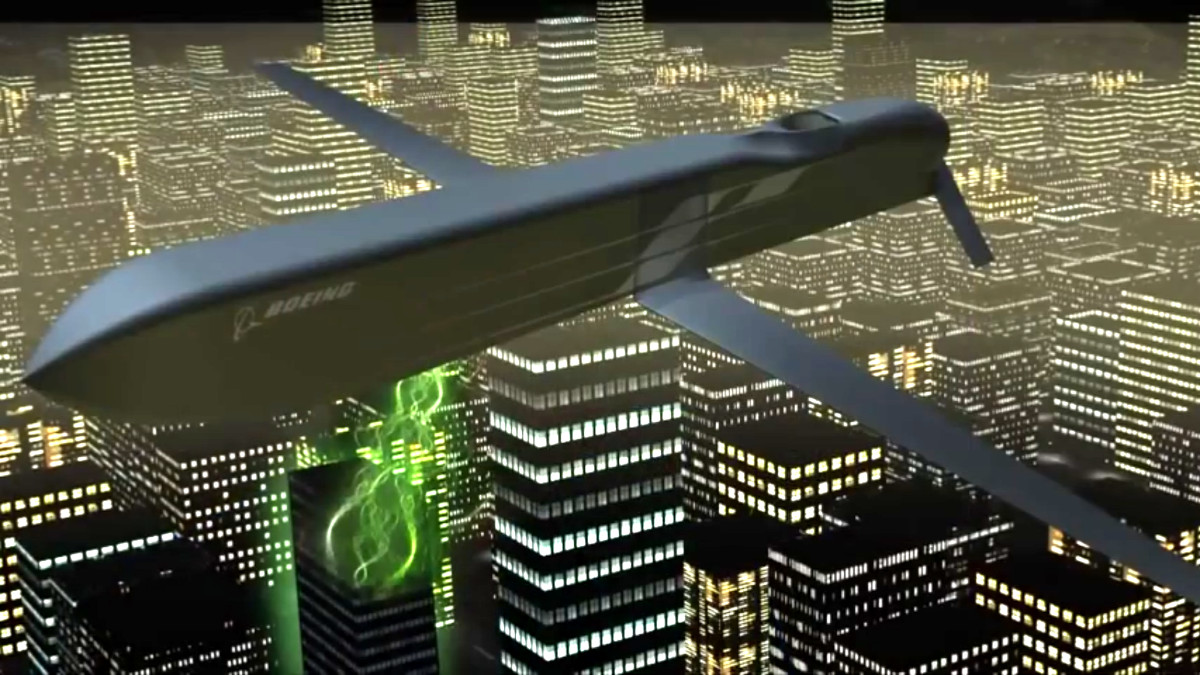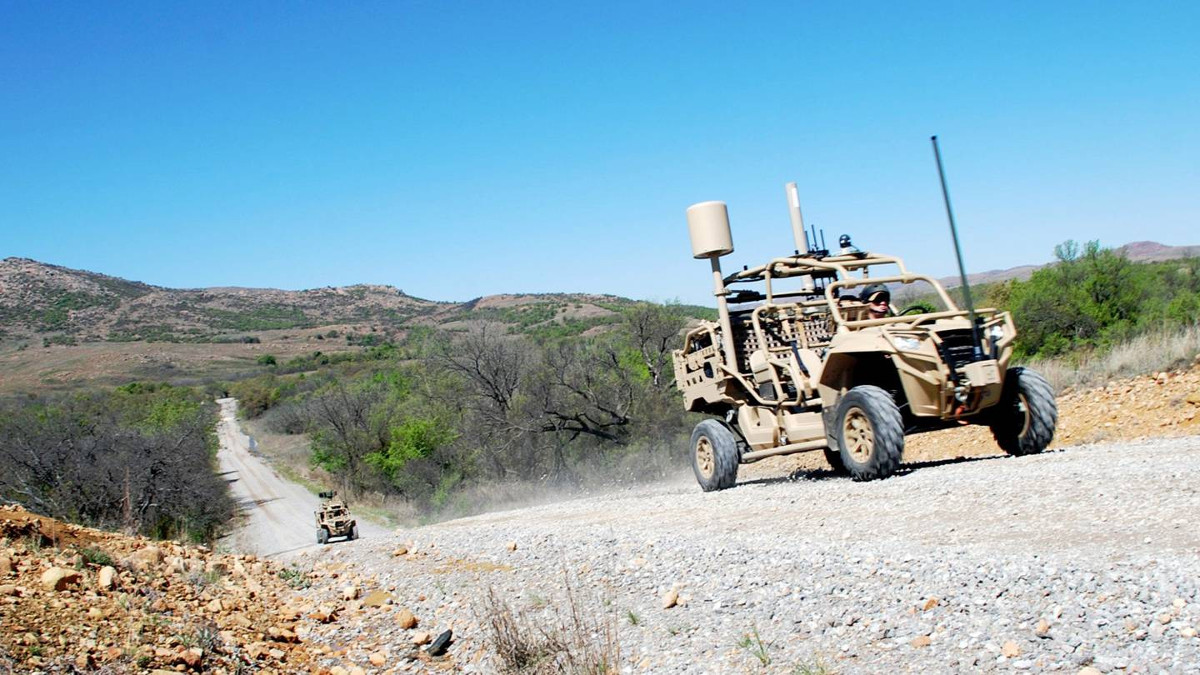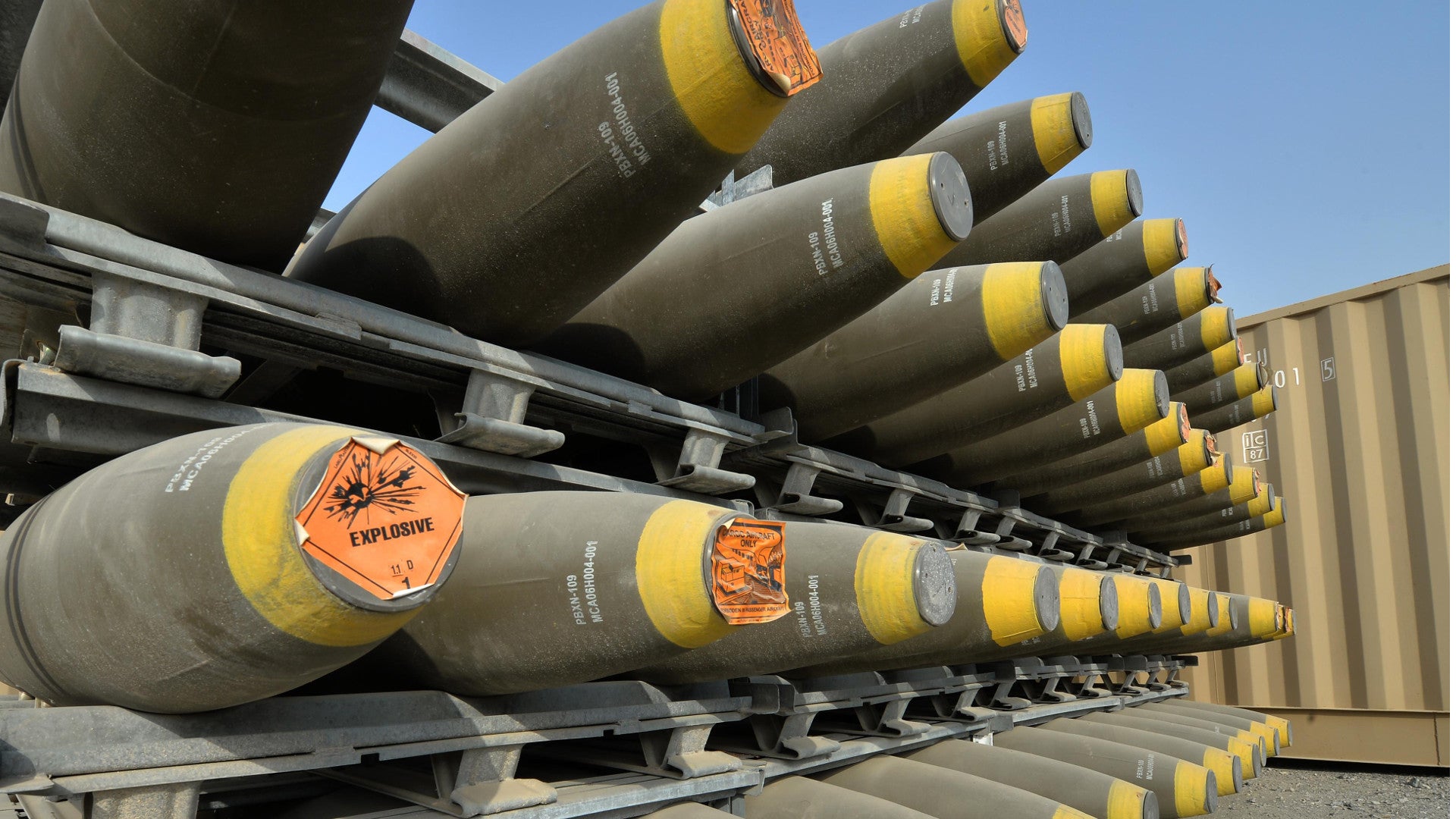It sounds like something straight out of Call of Duty video game sequel, James Bond movie, or Batman comic. Troops call in an air strike, but instead of high explosives, the pilots employ a weapon that screws with the enemy’s electronics, disabling them or making them catch fire or even explode, becoming little bombs in of themselves. But it’s not a plot device from a Hollywood blockbuster or video game. It’s a detail passed along from a journalist in Syria – and what’s more, some part of the report might be true. We’ve seen at least one similar rumor emanating from a modern battlefield in the past.
The new report emerged on July 7, 2017, when Jenan Moussa, a “roving reporter Arabic Al Aan TV,” an Arabic-language satellite television network with its headquarters in the United Arab Emirates, wrote on Twitter that members of the U.S.-supported Syrian Democratic Forces told her American warplanes sometimes dropped an “electricity bomb.” The SDF fighters added that when the weapon went off, anyone carrying metallic items would “burn.”
“They call it electricity bomb here bcz [because] they don’t know real name,” Moussa wrote in a string of Tweets that included video and pictures from the city of Raqqa, ISIS’ de facto capital. “When plane wants to drop electricity bomb, we are told to drop anything metal that we carry. Otherwise we also burn like ISIS fighters.”
Right from the start it sound like a conspiracy theory and many are likely to quickly dismiss it as such. To be sure, the idea that a “bomb” would cause metal objects to become so hot as to burn anyone carrying them, or any similar effect sounds like an easy recipe for a civilian casualty nightmare with the potential for innocent people to get burned at the dinner table by their own silverware and children to get injured by their metal toys. But what if it wasn’t a bomb or a missile, at least in the traditional sense?
What if the weapon described by fighters to Moussa was actually focused microwave beam, highly localized electromagnetic pulse munition, or even some sort of pinpoint cyber attack? Maybe the SDF fighters saw the aftermath of any one of these types strikes and assumed the metal parts had burned up because they were the target of such weapon rather than just secondary effect from its use. Or maybe people’s cell phones are catching fire or exploding and it isn’t clear why, which is hardly an unheard of concept.
The idea of a weapon that could fit on an unmanned aircraft and stop cars using a pulse of energy or ignite cellphones at the flip of a switch would definitely be a desirable new capability if engineers could get it to work. It is hardly the most outlandish concept the U.S. military or American intelligence agencies have ever pursued. What we do know is this sounds an awful lot like another strange report we’d heard of before and it seems possible, at least in part, based on weapons and other equipment that already exists, or that could potentially exist clandestinely, that some kernal of truth could be behind them.
If anything else, these rumors can act as a jumping off point for us to brainstorm how the weapons of tomorrow could obtain such tactical effects, regardless of if they actually exist today or not.

An old rumor
Moussa’s report from Syria fits loosely with at least one other equally vague report dating back more than five years. The common theme between the two is the broad description of some sort of electronics-busting weapons that hamper enemy activities rather than necessarily killing them outright.
In November 2011, the international wire service AFP ran a story about secret American teams guarding chemical weapons stockpiles in Libya. With the help of a NATO-led air campaign, rebels overran these sites as they overthrew the regime of long-time strongman Muammar Gaddafi. Fearing these weapons of mass destruction could fall into terrorist hands in the ensuing chaos, the Central Intelligence Agency (CIA) and the U.S. military, swooped in to guard the chemical-filled bunkers.

“Stun bombs had also already been used against other fighters roaming on the site some days earlier, recalled Safi ad-Din,” according to AFP’s report. “All the curious ones risk an air strike if they get closer than 50 meters (yards) to the chemical bunkers.”
It was unclear whether ad-Din, a Libyan chemical weapons “expert” who was working with the American personnel, was referring to an air-dropped weapon of some description or a more mundane weapon like a flashbang or stun-ball hand grenade. However, Ahmed Misrati, who AFP described simply as a “fighter,” separately added that an airstrike had previously “destroyed” a car with two occupants “without anybody even being hurt.”
This would have been quite a feat for a specialized high-explosive weapon like the BLU-129/B Very Low Collateral Damage Bomb or even an inert, concrete-filled type. Purpose-built designs like these are still very lethal, as we saw when something similar killed Abu Khayr al Masri, then Al Qaeda’s number two man, in Syria in February 2017.
Instead, what ad-Din and and Misrati seemed to be describing was some sort of airborne or air-dropped less than lethal weapon that could stun personnel or cripple a car’s operating electronics. As fanciful as that idea sounds, this would be in line with technology the U.S. military has been working on and demonstrated in laboratory settings since before the intervention in Libya.

Very real weapons
The desire for weapons that provide “scalable” effects ranging from disrupting to destroying electronics and associated power infrastructure already make perfect sense. Electronics have become essential to modern military operations, from navigation to targeting and more. On top of that, concerns about civilian casualties have become an increasing important issue, especially in limited conflicts against terrorists and insurgents where air strikes are very likely to occur in densely packed urban environments full of innocent bystanders – like Raqqa.
In 1991, the U.S. Navy fired so-called “Kit-2” Tomahawk Land Attack Missiles into Iraq. These dropped spools of highly-conductive carbon fiber wire over power stations causing short circuits. Though there are few other available details about this configuration, the missiles were reportedly responsible for decimating Iraqi power generation during the conflict.

In 1999, F-117 Nighthawk stealth fighters did the same thing in Serbia, but this time using special cluster bombs full of BLU-114/B submunitions. The press quickly dubbed these previously undisclosed weapons, each full of graphite filament, “soft bombs” and “blackout bombs.” Unfortunately, carbon fiber and graphite payloads only work on uninsulated power lines, which greatly limits their overall usefulness.
Since then, the U.S. military has publicly pushed to develop directed energy weapons – a broad category that includes both lasers and high power microwave beams – to produce more consistent effects, as well as narrowing the focus of an attack closer to the target itself and otherwise limit any collateral impact.
In 2012, one such design emerged as part of a project known as the Counter-electronics High Power Microwave Advanced Missile Project, or CHAMP. Unlike the earlier weapons, this design, tucked away inside a stand-off cruise missile, featured a powerful microwave emitter that could knock out electronics with its pulsing beam.

In a test, the U.S. Air Force and prime contractor Boeing had successfully used prototype unit, inside a modified AGM-86 air-launched cruise missile, to knock out a number of target computers in a mock, two-story office building. The missile went on to attack other targets at a test range in Utah before crashing at a predetermined location.

Two years later, the U.S. Air Force claimed it would have a working “counter-electronics weapon” prototype by the end of the decade. As of 2015, the Air Force was still actively working on the CHAMP concept, with plans to install the device on the stealthy Joint Air-to-Surface Standoff Missile-Extended Range (JASSM-ER) cruise missile. However, the service has been especially secretive about the progress of the program or whether it has experimented with installing the equipment itself in manned or unmanned aircraft.
There is also the possibility that properly configured and suitably powerful electronically scanned array radar arrays might be able to create similar damage by shooting out narrow beams of high power electromagnetic energy at certain targets types.
At the same time, the U.S. Army, Air Force, and Marine Corps have experimented with ground-based, less than lethal “pain-rays” for crowd control and other purposes, including a large vehicle-mounted arrangement known as the Active Denial System (ADS). The Air Force has talked about possibility installing this sort of equipment on AC-130 gunships and other aircraft in the past, too.

These systems use a high power microwave beam to make subjects feel as if “their skin is on fire,” but it leaves no lasting wounds. There remains perpetual concerns, however, that ADS and other related devices could do real damage if someone turned the power up high enough or tuned the system to the wrong frequency. The potential fear, justified or not, of injuring or even killing someone with an officially “non-lethal” weapon has been one explanation as to why the U.S. military deployed one prototype ADS to Afghanistan, but never used it.
But maybe most importantly, the U.S. Navy has been hard at work on radio-frequency disruptors than can zap the engine in a car or boat and bring them to a halt. One potential scenario would be bringing car or truck bombs to a halt before they can reach their target. If that doesn’t work, the same system might be able to trigger the explosives early, away from friendly forces. Engineers were already testing a prototype “RF Vehicle Stopper” during the 2008 fiscal year, according to a Naval Surface Warfare Center – Dahlgren Division presentation the author previously obtained through the Freedom of Information Act.

The same 2016 briefing said the hope was that the systems would be ready for field use by the 2017 or 2018 fiscal years. “Reduced size and weight will allow integration into multiple platforms,” one of the Powerpoint slides explained, which again could conceivably include manned aircraft or drones. A spin-off concept, the Pre-emplaced Electrical Vehicle Stopper (PEVS) was also in the works at that time. The equipment would act as an “electric, direct injection ‘speed-bump’ system [that] employs high voltage pulse to disrupt vehicle’s ECU [engine control unit],” another part of the briefing said. As such it “selectively stops single or multiple threat vehicles.”

The basic underlying technology has only been getting smaller and more portable, too. Raytheon, which manufactures both active electronically scanned array radars and the ADS, has found that gallium-nitritde makes for compact, highly efficient solid state emitters in radars. It’s latest Aegis and Enterprise Air Surveillance Radar (EASR) systems are built around groups of smaller units that fit neatly inside uniform two foot cubes. The firm hopes to ultimately translate some of these same principles to a new, smaller and more mobile active denial arrangement.
Raytheon is also responsible for the compact laser weapon that the U.S. Army tested on an AH-64 Apache gunship helicopter in June 2017, proving that a functional airborne laser weapon was no longer required a massive aircraft to haul it around, something that will only push other services to continue pursuing their own offensive and defensive directed energy projects. In addition, the U.S. military has seized on both miniaturized lasers and lightweight jammers as a key way of countering the emerging threat of small enemy drones, which will likely promote the development of other new directed energy technologies.

There are always cyber weapons, which the U.S. military has referred to as “cyber bombs” in the past, too. BAE Systems has already created a secretive computer program known as Suter that reportedly can trick radars into pointing the wrong direction or possibly crash military air defense networks altogether. Depending on how it breaches an opposing system, it could theoretically disable power regulating functions on various electronic equipment, causing them to overheat and either shut down or “burn” and destroy themselves. What little information available about Suter says it is almost entirely focused on countering air defense systems, but the same concept could apply to other networks electronic components as well.
We already know that the U.S. Intelligence Community did something similar in principle on a much more localized level in Iran. The famous Stuxnet worm crippled Iran’s nuclear enrichment program for a time by screwing with the industrial control software controlling the centrifuges, causing them to spin out of control and tear themselves apart. There was also reportedly a follow-on plan for a series of much more ambitious and widespread cyber attacks, known collectively as “Nitro Zeus,” in the event the Iran Deal failed.
In April 2017, the U.S. Army publicly disclosed it was working on a concept that envisioned a future where troops could call in cyber attacks like artillery fire. The service had tested a mobile system simply known as “Killer” that had the ability to use on board gear and unspecified space-based assets to disrupt nearby enemy networks. A separate “Hunter” vehicle was focused purely on knocking out small drones.

This is just what we know about, too. A 2012 U.S. Central Command (CENTCOM), which we also obtained via FOIA, outlines eight electronic warfare missions, including one that is classified secret. CENTCOM is the U.S. military’s top warfighting command for the Middle East and much of Central Asia, including overseeing the fight against ISIS in Iraq and Syria.
“Military action involving the use of [directed energy] weapons, devices, and countermeasures to incapacitate, cause direct damage or destruction of adversary equipment, facilities, and/or personnel or to determine, exploit, reduce, or prevent hostile use of the [electromagnetic spectrum] through damage, destruction, and disruption,” is how the regulation describes directed energy warfare. The redacted mission could involve other kinds of distributed attacks that might be able to create similar effects.

It is very possible, if almost a certainty, that, just like still secret manned aircraft and drones, there are exotic payloads and weapons that have yet to make it out into the light. The U.S. military, including the NSA, and the CIA already track targets for more conventional air strikes via their cellphone signals alone. It’s not hard to imagine a podded microwave beam and one small enough to fit on an unmanned vehicle that could be flying over Raqqa zapping terrorist electronics.
A malware toting cyber weapon, or a drone carrying a directed energy weapon capable of turning that phone into a searing hot iron that injures or maims the individual carrying it on the spot sounds like the sort of thing the CIA would be interested in if it was at all feasible. It would help explain why the SDF told Moussa they had to drop everything rather than just power down any electronic devices until the threat had passed by the group.
When it comes to clandestine flying directed energy weapons, and even the ability to deliver a cyber weapon to certain networks directly, those are the kind of exotic payloads that engineers might be able to keep hidden at a number secretive test sites, such as the one at the edge of Yucca Dry Lake near Area 51. This testing facility, sometimes called Area Six, reportedly has ties to the CIA’s own unmanned aircraft programs and associated equipment.

Confusion, disinformation, and tall tales
Now, there is still the distinct possibility that this latest story from Syria is a misinterpretations of first- or second-hand accounts or outright fabrication on the part of the SDF. Their claims could be a part or the product of active disinformation campaigns or other psychological warfare. On battlefield story may simply have taken on a life of its own.
There is always a certain fear of the unknown in warfare and this would be especially true for irregular groups fighting against larger, more technologically superior foreign opponents. Maybe rumors of almost absurdly advanced weaponry is how fighters are inclined to frame their disadvantages. However it happens, we’ve seen these sorts of stories develop organically many times before.
Notably, after the 2003 invasion of Iraq, the U.S. military found that insurgents had somehow come to the conclusion that the orange air identification panels on M1 Abrams tanks and other armored vehicles, there to help prevent friendly fire incidents, were actually force field generators. As a result, American forces began to find RPG warheads covered in electrical tape or with plastic bags, which militants also thought was enough to break through this barrier.

Another popular example is of Liberian rebels in the 1990s and 2000s who wore orange life jackets and other mismatched clothing items imbued with magic to make them impervious to bullets. There are countless similar stories from conflicts the world over, often with few obvious explanations as to how the specific battlefield superstition came about.
The “electricity bombs” in Syria and the “stun bombs” of Libya could very easily be bogus, too. But at the same time, we do know that the U.S. military is working to make a broad selection of weapons with similar sounding capabilities a reality.
So, just perhaps, the SDF fighters in Raqqa weren’t as crazy as they seemed at first glance.
Contact the author: joe@thedrive.com
